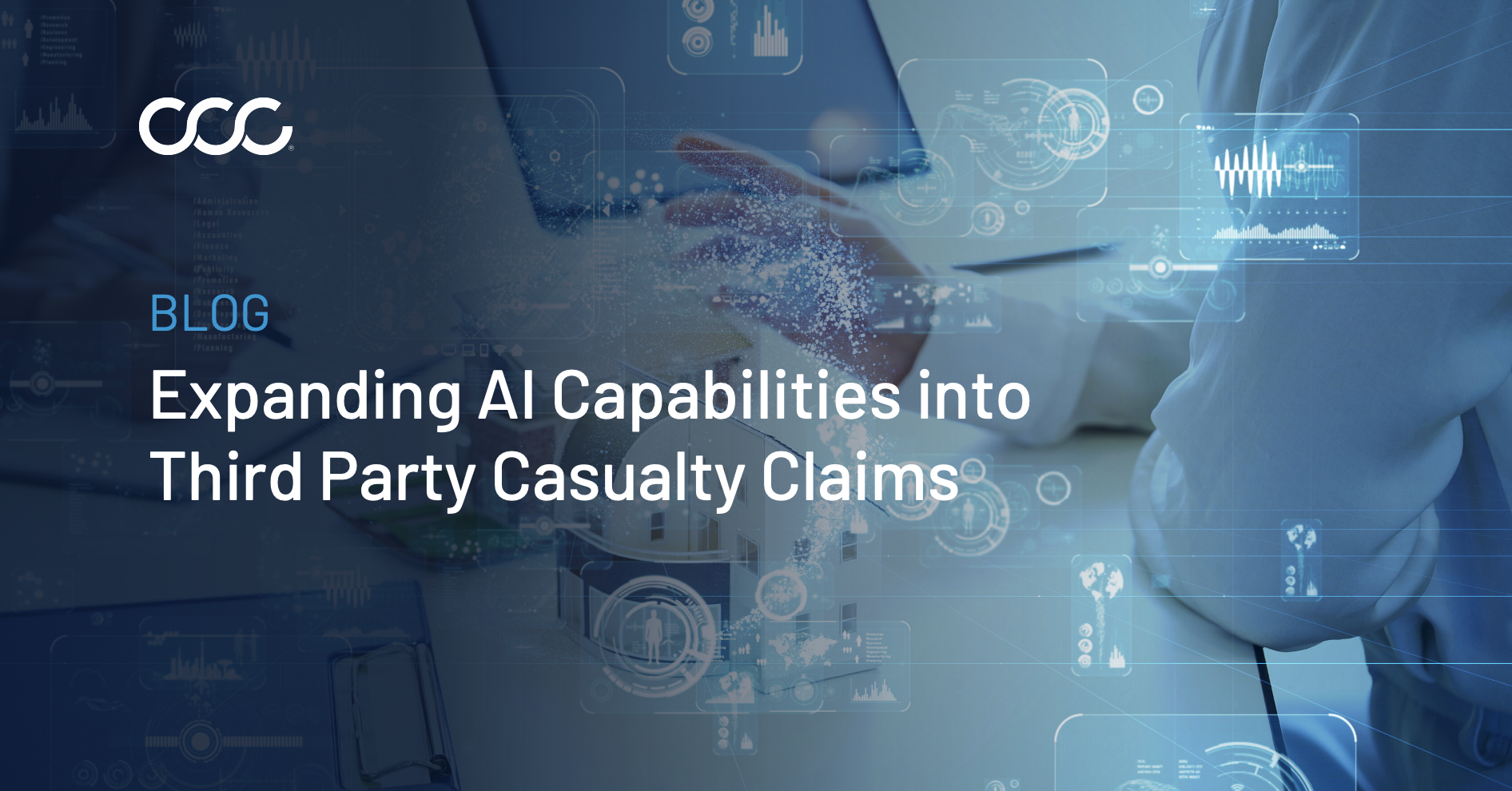by John Goodson, SVP of Product Development
Artificial intelligence represents a fundamental shift in how businesses can make use of the tremendous amounts of data available. Digital interactions between customers and business partners create millions of data points daily – AI can synthesize all of this data to create actionable insights, and even automate tasks based on that data to speed up and simplify lengthy and complex processes. Every industry needs to get AI right in order to create more efficient processes, better informed decision-making, and enhanced customer experiences. Arguably, no industry generates more data nor has a greater opportunity to optimize the service experience of their many millions of customers than the insurance industry.The challenge for insurance companies evaluating AI solutions and providers is that superficially all AI seems the same. Yet nothing could be further from the truth. AI has become an all-encompassing term for what is actually a distinct set of disciplines and approaches that can be applied individually or in combination, delivering varying degrees of accuracy, predictability, and utility.
AI Fundamentals
AI is commonly referred to as predictive recommendations or predictive behavior. For the insurance industry, when an accident occurs, hundreds of decisions need to be made to properly remediate claims and restore the customer to pre-accident condition. For example, determining whether the vehicle is repairable or a total loss is an important initial determination, as it sets the path for the follow-on series of events.If repairable, how many parts are needed, which ones, and how will they be sourced? From a car manufacturer, salvage yard, aftermarket supplier? Cost is not the only variable in these decisions; what about time to secure the part, condition of the part, parts utilization metrics for the vehicle at hand, repair procedures/requirements, warranties, or rebates that might occur if purchase volume thresholds are met in some time period? In order to answer these questions and make an accurate recommendation, the AI model needs access to all the right rules, which may be determined by insurance carriers or other deciding parties and are subject to change. Only the most sophisticated AI solutions have the required access and data to account for all of these factors.
Applying Multiple AI Disciplines to Insurance
Beyond the datasets mentioned above, another key difference in AI efficacy is the use of the many available software models that make the AI most effective and “intelligent”.Deep-learning is an AI method that uses historical data to inform which action is likely to occur. Let’s take photo-estimating as an example. In order to build an AI model that can review smartphone images from a collision and accurately predict whether a vehicle is repairable versus a total loss, the AI model needs to learn from historical data: photos of other car crashes, as well as the claims data that accompanies those photos regarding the parts, labor, and cycle time for each claim. The question is: does the AI model have enough historical data to make that prediction accurate? A few hundred images are helpful, but decades’ worth of wrecked car images and related metrics makes the AI model infinitely smarter. Another question: can the AI model sort out the anomalies from the requisite data set? Can it learn from them?Machine-learning allows for the historical data to be influenced by changes in historical patterns that might make recent actions more likely to occur again. Let’s say you have been a Starbucks customer for the last 5 years, but more recently you’ve been buying your lattes from an independent coffee shop. In this case, the majority of data would say you’re going to visit Starbucks again, but recent activity would suggest the independent coffee shop is a better prediction. Why does this matter? Vehicles and parts are not static. New cars and parts are introduced continuously; if an AI solution is going to be effective, it needs to base predictions on data that can account for recent behaviors, not just historical data.A rules-based approach can offer helpful predictions when historical data is not available or recent activity is not accurate enough to ensure a meaningful prediction. Suppose that an inbound technical support email contains the word ‘urgent’ in the body. A rule is triggered, and that email is forwarded to someone who can immediately act on it. These types of rules can get into extremely complex decision points leading to hundreds of potential rules, some of which may even conflict with each other. This is why strictly rules-based AI is an incomplete approach that can fall short in accuracy and reliability. Yet, because data and domain experience aren’t required to create rules-based AI, it is a helpful starting point that can assist companies to begin the journey of automating complex workflows such as auto insurance.
Combining AI Disciplines for a Smarter Approach
The key takeaway is this: no single AI approach fits all use cases. A combination of these methods can help companies deliver the most predictive, comprehensive results for faster, smarter resolutions.CCC’s approach to AI is inherently unique, leveraging more than $1 trillion in historical claims data, including roughly one billion images, to deliver precise, comprehensive predictions across the auto physical damage claims lifecycle. CCC combines claims logic derived from 200M + claims transactions, customer-specific rules, and machine- and deep- learning, with mathematical simulations to power personalized decisions at scale to provide unprecedented clarity, identify anomalies used to reduce risks, improve performance, and elevate the customer experience. Today, more than 75 auto insurers use our advanced AI across multiple decisions in the claims process.Curious about how our AI solutions can transform your workflow? Let’s talk.
by John Goodson, SVP of Product Development
Artificial intelligence represents a fundamental shift in how businesses can make use of the tremendous amounts of data available. Digital interactions between customers and business partners create millions of data points daily – AI can synthesize all of this data to create actionable insights, and even automate tasks based on that data to speed up and simplify lengthy and complex processes. Every industry needs to get AI right in order to create more efficient processes, better informed decision-making, and enhanced customer experiences. Arguably, no industry generates more data nor has a greater opportunity to optimize the service experience of their many millions of customers than the insurance industry.The challenge for insurance companies evaluating AI solutions and providers is that superficially all AI seems the same. Yet nothing could be further from the truth. AI has become an all-encompassing term for what is actually a distinct set of disciplines and approaches that can be applied individually or in combination, delivering varying degrees of accuracy, predictability, and utility.
AI Fundamentals
AI is commonly referred to as predictive recommendations or predictive behavior. For the insurance industry, when an accident occurs, hundreds of decisions need to be made to properly remediate claims and restore the customer to pre-accident condition. For example, determining whether the vehicle is repairable or a total loss is an important initial determination, as it sets the path for the follow-on series of events.If repairable, how many parts are needed, which ones, and how will they be sourced? From a car manufacturer, salvage yard, aftermarket supplier? Cost is not the only variable in these decisions; what about time to secure the part, condition of the part, parts utilization metrics for the vehicle at hand, repair procedures/requirements, warranties, or rebates that might occur if purchase volume thresholds are met in some time period? In order to answer these questions and make an accurate recommendation, the AI model needs access to all the right rules, which may be determined by insurance carriers or other deciding parties and are subject to change. Only the most sophisticated AI solutions have the required access and data to account for all of these factors.
Applying Multiple AI Disciplines to Insurance
Beyond the datasets mentioned above, another key difference in AI efficacy is the use of the many available software models that make the AI most effective and “intelligent”.Deep-learning is an AI method that uses historical data to inform which action is likely to occur. Let’s take photo-estimating as an example. In order to build an AI model that can review smartphone images from a collision and accurately predict whether a vehicle is repairable versus a total loss, the AI model needs to learn from historical data: photos of other car crashes, as well as the claims data that accompanies those photos regarding the parts, labor, and cycle time for each claim. The question is: does the AI model have enough historical data to make that prediction accurate? A few hundred images are helpful, but decades’ worth of wrecked car images and related metrics makes the AI model infinitely smarter. Another question: can the AI model sort out the anomalies from the requisite data set? Can it learn from them?Machine-learning allows for the historical data to be influenced by changes in historical patterns that might make recent actions more likely to occur again. Let’s say you have been a Starbucks customer for the last 5 years, but more recently you’ve been buying your lattes from an independent coffee shop. In this case, the majority of data would say you’re going to visit Starbucks again, but recent activity would suggest the independent coffee shop is a better prediction. Why does this matter? Vehicles and parts are not static. New cars and parts are introduced continuously; if an AI solution is going to be effective, it needs to base predictions on data that can account for recent behaviors, not just historical data.A rules-based approach can offer helpful predictions when historical data is not available or recent activity is not accurate enough to ensure a meaningful prediction. Suppose that an inbound technical support email contains the word ‘urgent’ in the body. A rule is triggered, and that email is forwarded to someone who can immediately act on it. These types of rules can get into extremely complex decision points leading to hundreds of potential rules, some of which may even conflict with each other. This is why strictly rules-based AI is an incomplete approach that can fall short in accuracy and reliability. Yet, because data and domain experience aren’t required to create rules-based AI, it is a helpful starting point that can assist companies to begin the journey of automating complex workflows such as auto insurance.
Combining AI Disciplines for a Smarter Approach
The key takeaway is this: no single AI approach fits all use cases. A combination of these methods can help companies deliver the most predictive, comprehensive results for faster, smarter resolutions.CCC’s approach to AI is inherently unique, leveraging more than $1 trillion in historical claims data, including roughly one billion images, to deliver precise, comprehensive predictions across the auto physical damage claims lifecycle. CCC combines claims logic derived from 200M + claims transactions, customer-specific rules, and machine- and deep- learning, with mathematical simulations to power personalized decisions at scale to provide unprecedented clarity, identify anomalies used to reduce risks, improve performance, and elevate the customer experience. Today, more than 75 auto insurers use our advanced AI across multiple decisions in the claims process.Curious about how our AI solutions can transform your workflow? Let’s talk.




